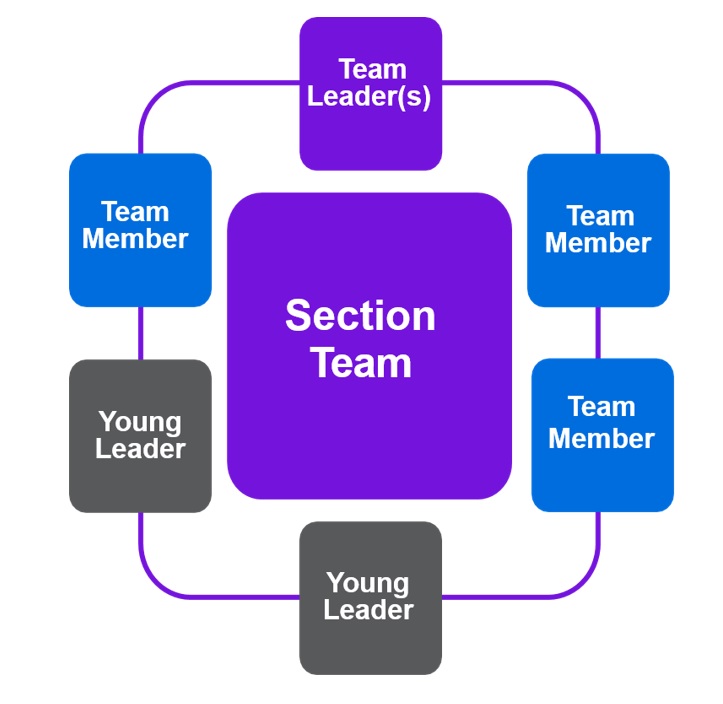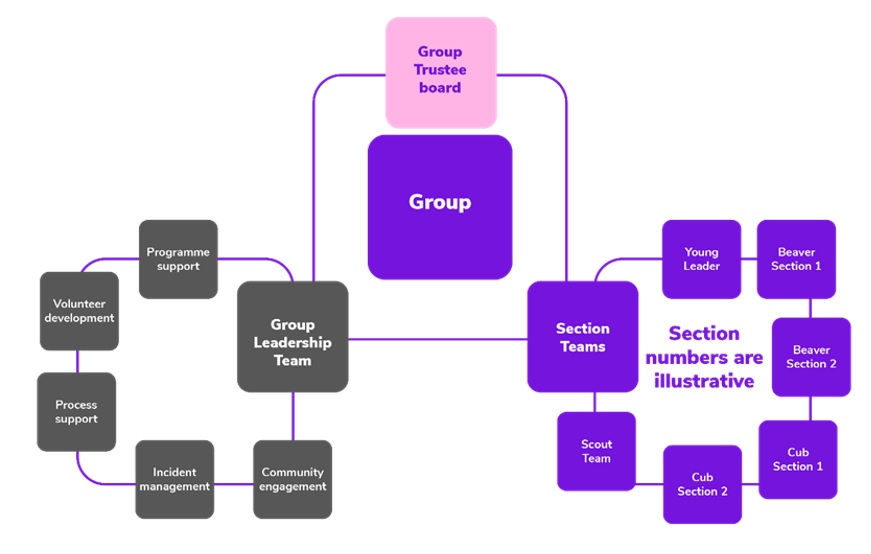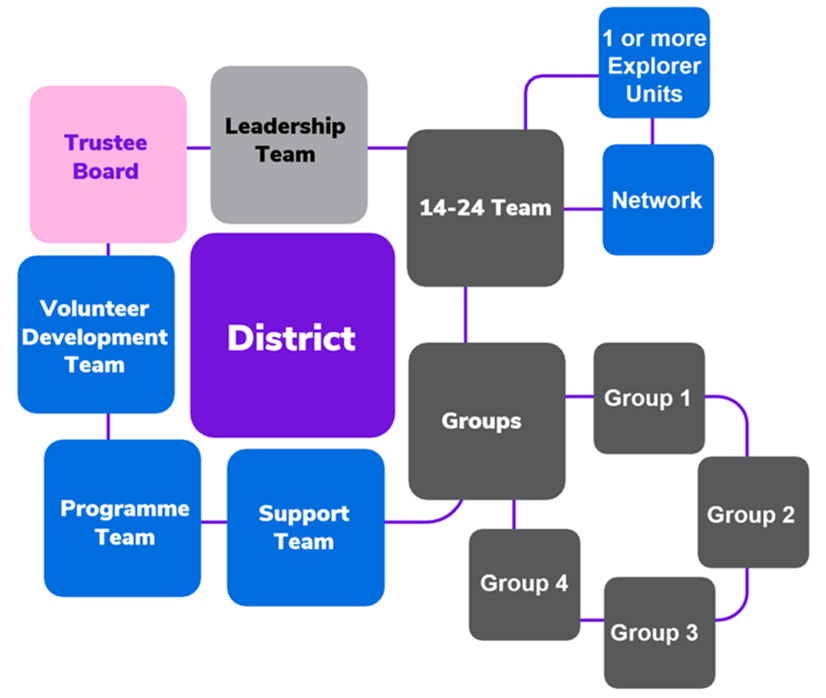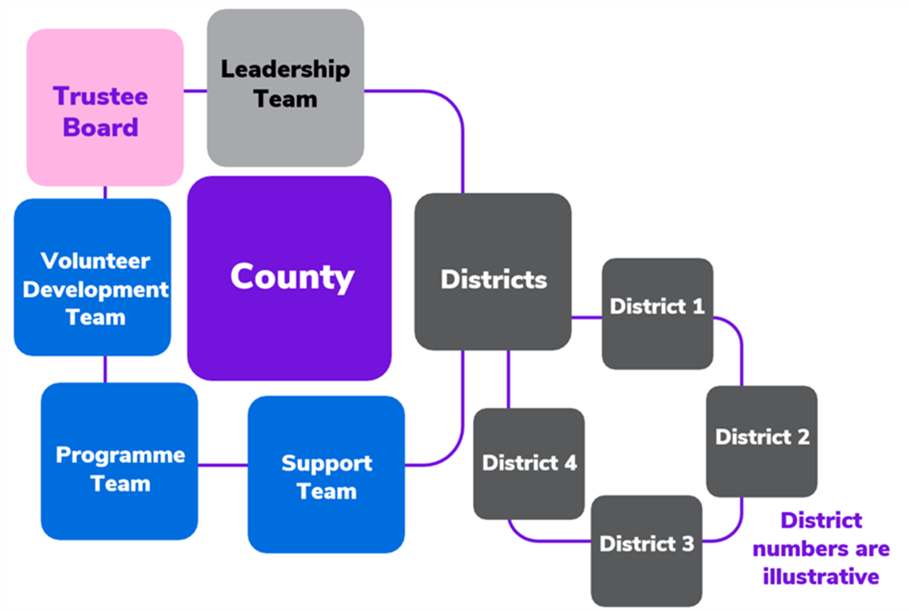Simplifying volunteering
How we'll simplify how we volunteer together for positive volunteering everyday
Quick links
How we'll simplify how we volunteer together for positive volunteering everyday
Moving to teams-based volunteering: volunteering in teams with a clear purpose and shared tasks
- All volunteers will be part of a team. Some places already volunteer in effective teams, but we want this to happen everywhere. We already know from local successes that people achieve more in teams.
- A team shares a Team Description, which gives a purpose, outcomes and tasks for the team. This will be a mixture of tasks for the whole team and allocated tasks for a particular people that the team can agree on. These will replace the current Role Descriptions.
- A team can decide between themselves how to allocate the tasks to suit volunteers’ skills, interests and availability. This makes flexible volunteering normal and available to everyone.
- Teams have team leaders. This could be one or more people, and they’ll coordinate the tasks with the team.
- Our systems and processes will support volunteering in teams.
- As part of these changes, what we call our volunteer roles will change. Our role titles will be updated to reflect how we volunteer now.
- Updating role titles will also ensure they’re understandable and appealing for new and current volunteers. Some named roles will be retained – where these serve clear purpose such as Treasurer or Permit Assessor.
Why we need to make sure how we volunteer is right for current and new volunteers, as well as for young people
At the moment:
- We have too many roles, which can be unmanageable, fixed and too often feel like work.
- They can be hard to understand, and expectations when someone joins or moves role are often unclear. They can put people off from joining - ‘I couldn’t do what you do.’
- We have a few people with lots of responsibility (and stress) placed on them. This can often make volunteering tip into feeling like work.

We don’t feel supported by the district. And it scares me, because I quite often worry that I’m just gonna melt and say, ‘I can’t do this any more'.
Group Scout Leader
For current volunteers to have a good experience and attract new volunteers:
- We need our roles to be appealing to more and different people, including those who have never been involved in Scouting. This means that we’ll increase the numbers of volunteers who join us and increase the diversity of our volunteers.
- We need to make some of our roles more effective at supporting the delivery of great programmes to young people. That’s what we’re here for. If we refocus our roles around what is needed in Scouts today, every hour a volunteer gives makes an even bigger difference to young people.
- We need to be clear about what roles should be doing and how they fit in with other volunteers to reduce duplication. This means that we know who’s doing what and we all get more out of the time we put in.
- We need to share tasks from our key leadership roles to reduce the workload of our Group Scout Leaders (GSLs), District Commissioners (DCs) and County Commissioners (CCs). Over time, this will make these roles more accessible and appealing to a broader group of people.
- We need what we call our roles to be more understandable both to those inside and outside of Scouts, so that people understand what we do and join us.
The impact on volunteers
- All volunteers will move into updated teams. For some, volunteering in a team may be a big change and for others, it may be closer to what they’re doing already.
- For most volunteers, their role title will also change.
- For some volunteers in District and County teams, there may be a bigger change in what their role does, due to other changes that are coming too, such as those who are involved in training and welcome.
- Many volunteers are volunteering in teams already. This sets up our processes in a way to support and enable that.
- Increased flexibility, so people can volunteer in a way that works for them. Over time, this should increase the numbers of volunteers that we recruit, including different groups of people who may not have volunteered with us before.
- Teams can organise themselves in the way that works for them.
- Section Assistant, Assistant Section Leader and Section Leader will no longer be separate roles. They will combine to be the same role, creating simplicity for new and existing volunteers.
- It’ll make it clearer what District and County teams do with less duplication, so there’s more time to support great programmes for young people.
- It's difficult to lead other people through change while their own role is changing.
- Some volunteers whose roles will change the most may need a lot of support.
- Some volunteers will find that the change in mindset from people doing individual roles to volunteering as a team is a challenge.
'I don't want to share out tasks'
You may feel there’ll be less control if you’re sharing out the tasks you normally do. However, you can do this in a way that works for the volunteers in your team.
'We don't have enough volunteers to create these teams'
We know recruitment is already a barrier. That’s why these changes should make it easier for people to get involved. We’re also reviewing our welcome processes at the same time to make sure these encourage new volunteers, rather than put them off joining.
And when you get new volunteers, the team approach will make it easier for them to join in a way that works for them.
'This is already happening'
We know lots of people are volunteering in teams already, and we want to ensure our processes support that. However, it is not happening everywhere, so want to make this normal for all volunteers in Scouts.
'UKHQ/Nations roles aren't changing right now, so why should we?'
We’ve started with the teams that are closest to – and therefore have the most direct impact upon – the programmes delivered to young people. We plan to review UKHQ & Nations teams in 2023/24.
What this will look like in reality
There’ll be lots more information and detail coming over the next few months, including all the support materials and what exactly this will mean for each of our current roles.
Our structures will still be arranged in Sections, Groups, Districts and Counties.
Sections

View the Section Team diagram in full screen.
The Section Team will be made up of Section Team Members, Young Leaders and Section Team Leaders(s). There’ll no longer be a distinction between Section Assistants and Assistant Section Leaders. The team will share out tasks in a way that works for them.
Groups

View the Group diagram in full screen.
There’ll be a Group Leadership Team, which includes the Section Team Leaders and any other volunteers. This’ll be led by the person leading the Group. This means that all the things the Group does shouldn’t default to just the Group Scout Leader. There’s also a Trustee Board at Group Level, which provides governance to the Group.
District

View the District diagram in full screen.
At District, the teams are split into 5 areas. There are brief summaries of each below. There is a lot more detail that will be released soon for feedback, including the Team Descriptions for each.
- Leadership Team – lead, inspire and motivate
- Trustee Board – provide governance
- Programme Team – bringing Section roles together/ with other activity experts
- Volunteer Development Team – ensuring our volunteers are well supported
- Support Team – keeping things running smoothly such as incident management
There is also 14-24 Team at a District Level supporting Explorers and Network. The Team Leader also feeds into the District Leadership Team in the same way that the team leaders for group feed into the Leadership Team.
County

View the County diagram in full screen.
At County, the teams are split into 5 areas. There are brief summaries of each below. There is a lot more detail that will be released soon for feedback, including the Team Descriptions for each. The remits of each of these teams at County level with be distinct from but compliment the purposes of the teams at District.
- Leadership Team – lead, inspire and motivate
- Trustee Board – provide governance
- Programme Team – bringing Section roles together/ with other activity experts
- Volunteer Development Team – ensuring our volunteers are well supported
- Support Team – keeping things running smoothly such as incident management
What will stay the same
Our structures will still be arranged in Sections, Groups, Districts and Counties, as well as broadly the tasks that happen at each level. For example, Section Teams will still deliver programmes to young people.
Even if our structures look different, you should still be able to volunteer in the area that is of most interesting to you, such as working with young people, delivering excellent governance or giving support to other volunteers.
Who’s leading the positive volunteering project
- Rich Bennett, Project Lead: How We Volunteer
- Pete Jeffreys, Project Lead: How We Volunteer
- Laura Congreve, Volunteer Journey Executive (Volunteer Framework)
- Alex Harvey, Volunteer Framework Theme Lead
Further information
Head to the Testing Hub to watch the videos about these changes.
There are videos about the principles of the role changes, such as team-based volunteering and roles designed around programme delivery, changes to role titles, example section and group team descriptions, and how we want our culture to feel.
More engaging learning
How we’ll create a more engaging learning experience.
Discover the new learning experienceDigital support
How we’ll give you more digital support to help get things done.
Find out about the new toolsA warmer welcome
How we're planning to create a warmer welcome for everyone.
Discover the plans for a warmer welcome